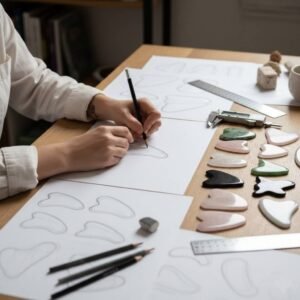
If you’re interested in natural and alternative therapies for health and wellness, you may have heard of Gua sha and cupping. Both techniques have been used for centuries in traditional Chinese medicine, and both involve manipulating the skin to promote healing and relaxation. But what is the difference between Gua sha and cupping, and which one is better? In this article, we’ll dive deeper into these questions and explore the benefits, uses, and risks of these ancient practices.
- What is Gua sha?
- What is Cupping?
- How to Use Gua Sha and Cupping?
- Gua Sha vs Cupping: Which one is better?
- What Things You Should Pay Attention to When Using Gua Sha or Cupping?
- Can Gua Sha be Used With Cupping?
- Conclusion
What is Gua sha?
Gua sha is a traditional Chinese therapy that involves using a smooth-edged tool, often made of jade or rose quartz, to scrape the skin in long, firm strokes. The goal of Gua sha is to stimulate blood flow, release tension, and promote healing by bringing stagnant energy or “chi” to the surface of the skin. Gua sha is often used for facial rejuvenation, as well as to relieve pain and stiffness in other parts of the body.
What are the Benefits of Gua sha?
Gua sha has been associated with several health benefits, including:
- Improving circulation and lymphatic drainage
- Reducing muscle tension and pain
- Promoting relaxation and stress relief
- Enhancing skin health and reducing wrinkles
- Boosting immune function
What is Cupping?
Cupping is a therapy that involves placing cups on the skin and creating suction to stimulate blood flow and relieve muscle tension. There are two types of cupping: dry cupping, which uses a vacuum pump to create suction, and wet cupping, which involves making small incisions in the skin to draw out toxins. Cupping is often used for pain relief, respiratory issues, and detoxification.
What are the Benefits of Cupping?
Cupping has been associated with several health benefits, including:
- Reducing inflammation and pain
- Promoting detoxification and improved digestion
- Relieving respiratory issues like asthma and bronchitis
- Boosting immune function
- Enhancing athletic performance and recovery
How to Use Gua Sha and Cupping?

Gua sha:
- Apply a few drops of oil to the skin to prevent friction.
- Hold the Gua sha tool at a 15-degree angle and apply firm pressure to the skin, using long strokes in a single direction.
- Repeat the strokes several times on each area, adjusting the pressure as needed.
- You can use Gua sha on different parts of the body, including the face.
Cupping:
- Apply oil to the skin to create a tight seal.
- Place the cups on the skin and create suction using either the fire or vacuum method.
- Leave the cups in place for several minutes, or move them around the skin for a massage-like effect.
- Cupping can be done on various parts of the body, including the back, legs, and arms.
Gua Sha vs Cupping: Which one is better?
The choice between Gua sha and cupping depends on your specific needs and preferences. Gua sha is more commonly used for facial rejuvenation and enhancing skin health, while cupping is often used for pain relief and detoxification. However, both practices can be effective in reducing pain, promoting relaxation, and improving overall health. Some practitioners even use Gua sha and cupping together for enhanced benefits.
What Things You Should Pay Attention to When Using Gua Sha or Cupping?
When using Gua sha or cupping, it’s essential to pay attention to the following things:
- Avoid applying too much pressure or using the tools for too long, as this can cause bruising or other skin damage.
- Do not use gua sha or cupping on broken or inflamed skin, as this can worsen the condition.
- Always use clean and sterilized tools to avoid infection.
- If you have any health conditions or are pregnant, consult with a healthcare professional before trying Gua sha or cupping.
Can Gua Sha be Used With Cupping?
Yes, Gua sha can be used with cupping for enhanced benefits. Some practitioners use Gua sha to prepare the skin before cupping by promoting circulation and releasing tension. Others use cupping to create suction and then follow up with Gua sha to release tension and promote circulation.
Conclusion
In conclusion, both Gua sha and cupping have been used for centuries in traditional Chinese medicine to promote health and wellness. While they have some similarities, they also have some distinct differences. Gua sha is often used for facial rejuvenation and enhancing skin health, while cupping is used for pain relief, detoxification, and respiratory issues. The choice between Gua sha and cupping ultimately depends on your specific needs and preferences. However, it’s essential to use them correctly and consult with a healthcare professional before trying them to avoid any potential side effects or complications. With proper use, Gua sha and cupping can be valuable tools for promoting health and wellness naturally.






